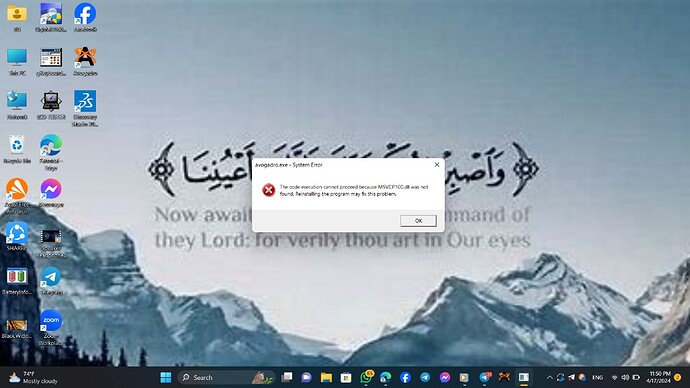@Ghada_Mahmoud Consider a more recent version. The GitHub page for instance provides you with daily builds for Windows, Mac, or Linux; or with stable releases.
There isn’t a version 1.5.7. It looks like you’re installing Avogadro 1.2.
There are a few links to that error message. If you need to install Avogadro 1.2 for some reason, Microsoft supplies an install:
https://www.microsoft.com/en-us/download/details.aspx?id=26999
If you’re using 32-bit Windows, you want vcredist_x86.exe - if you’re using 64-bit Windows, you want vcredist_x64.exe to install.
But as @Thomas mentions, I’d suggest installing for example a nightly build of the beta releases of https://two.avogadro.cc
Thank you for your email,
I am very for my fatal mistake, but i will try and can you give me the permission to email you if there is still something wrong.
Thank you in advance
No worries - if you search on the forum, you will see many similar questions.
The best thing if you have problems is to post back here on the forum, since it’s searched by Google for others to find the questions and answers. Thanks
Thank you, I will do that.
But still cannot download , the windows version is the problem
I’m not sure what you mean. In the screenshot, you downloaded Avogadro 1.2, but it wouldn’t run because of the problems with the MSVCP100.dll as indicated in the error message. I mentioned in my reply that you can install that from Microsoft - either the x86 version for 32-bit Windows, or the x64 version for 64-bit Windows.
@Thomas and I both suggested you can install a nightly build of Avogadro 2, which includes all the DLL. (Avogadro v1.2 was released years ago and various Microsoft updates have broken the installer.)
If that doesn’t make sense, can you please explain what problems you’re having in more detail? Thanks.
@Ghada_Mahmoud Do you plan some computational work on (I presume) your computer? If so, you might consider either a) to have a Linux installation side by side to the one of Windows as a second operational system (sometimes referred to as double-boot system, because while starting the computer, you will decide each time if you are going to work either in Windows, or in Linux), for instance Linux Mint, or Xubuntu as one of the flavors of Ubuntu. There are many more, but the two are examples of Linux which are easier to maintain and work with for a beginner in Linux.
Or b) to add to an existing installation of Windows a WSL subsystem – while running Windows, you are going to start a small instance of Linux within the already running session of Windows. Compared to variant a), this typically requires a bit more resources.
Either a), or b) do not intend to get rid of Windows for good. Instead, to benefit where possible from the advantages each operating system offers to the table. Perhaps there are some programs which only work in one, but not (so well) in the other operating system (e.g., ChemDraw in Linux can work, but isn’t always as smooth to install and run in Windows). But both would allow to pick and use the Linux AppImage (64 bit architecture) from the GitHub page in case working with Avogadro in Windows fails.
Rufus is a tool which would allow you to create a USB thumb drive with the .iso image of a Linux distribution to start, and boot a Linux initially living only in the working memory of the computer. From here, I would fetch the Avogadro AppImage, unzip the archive, provide the executable bit (there is a box in the file’s property tab if accessed in a file manager), and to launch it once for a test.
Though an eventually permanent installation of Linux side by side of an already existing operating system often is well documented (example Linux Mint), you might find assistance by senior colleagues of you (else: IT service desk, groups across the aisle active in physical/computational chemistry, a local/university based Linux user group) helpful, too. Before you do though, backup your installation/recovery media of Windows and your data outside of your computer.
